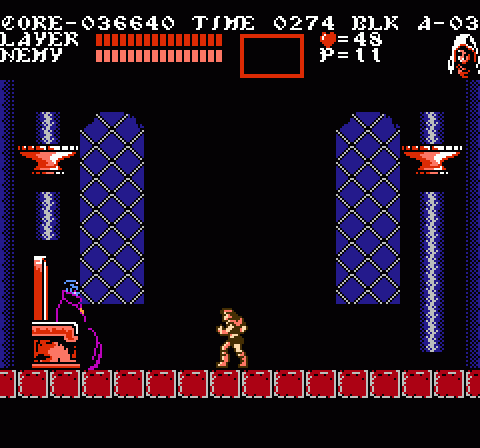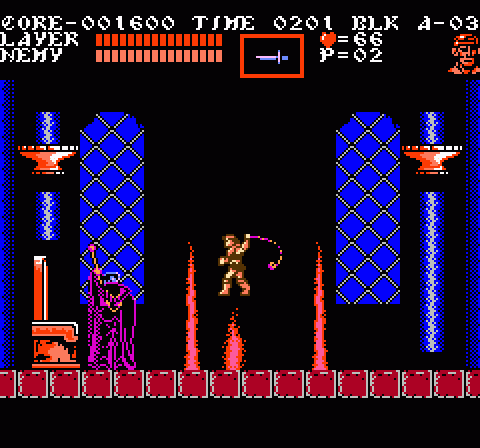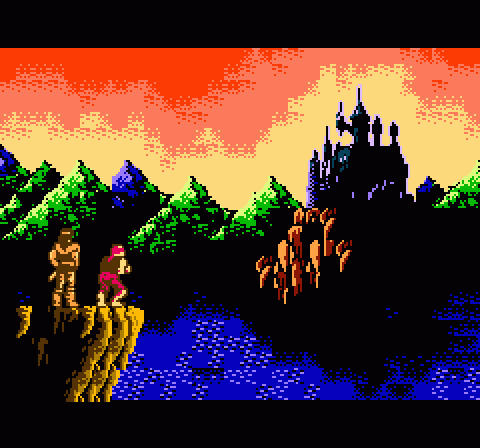Edit: Hello, Metafilter users! Thanks for visiting. If you dig this series, check back around February 15, as I’ll be reprinting these articles as a book with expanded text and more detailed stage layouts. Also, please thanks a million to VG Museum for providing the vast majority of the screenshots I’ve used in this series.
At long last, the trek through the NES Castlevania trilogy draws to a close. Block A brings Dracula’s Curse — and with it, the most aesthetically and mechanically consistent trio of games in the entire franchise — to a close. Alas, it’s something of an anticlimax. For starters, the music is gawdawful: Two bars set to a shrill, looping countermelody that plays over and over again. But more significantly, it feels rather, well, easy.

It’s as though the game used its entire bag of tricks in Block 9’s gauntlet of remixed elements, and this entire area simply exists because there has to be something between the beginning and Dracula. You’ll note some spiritual similarities to the final stage of Castlevania — the bridge-like railings here call back to the broken bridge patrolled by Phantom Bats, and there’s still a clock tower to be completed — but honestly Block A comes as a bit of a lull before the final conflict.

The bulk of Block A-01 consists of a trek through a clock tower. It’s an autoscrolling trek, in fact, which might lead you to expect something as devastatingly cruel as Block 9’s ratcheting tower. But no: You’re traveling downward here, and as you learned in Block 2, scrolling down a clock tower has nothing on the task of scrolling up. While there are a few mild hazards on tap — namely crumbling blocks and Medusa Heads — for the most part you can claim victory by simply hanging around and dropping to safe ground once it scrolls into sight.
The one notable challenge here is that Medusa Heads appear three at a time instead of two as usual. Still, that’s not really too big a deal. Oh, wait, there is one other tough part: At the very end of Block A-01, you make your way across an entire bridge of crumbling blocks… and guarding the door at the end is a Dragon Cannon. This is a total dick move, because a Dragon Cannon takes several hits to defeat — hits that you can’t easily deliver when the ground beneath your feet is vanishing. The most realistic way past this hazard is to jump into it and take the hit, dashing for the next block amidst your post-damage invincibility. Not cool, Dracula’s Curse.

Block A-02 doesn’t do much of note at first — you face off against familiar enemies in familiar settings — but eventually you climb to discover…

…three pendulums in a row. Once again, Block A reprises an element of Block 2, but this time it’s more difficult: You have to traverse three pendulums in a row, leaping from one to the next, with no room for failure.

And then, you very quickly arrive at Block A-03, which should seem very familiar. The music changes here to something much more interesting than the grating repetition of Blocks A-01 to A-01 as you climb the spur off the clock tower to Dracula’s chamber. As in the original Castlevania, you see the exterior of the clock looming above beneath the moonlight, though this time the tower has been framed in silhouette rather than presented in full detail.

As a nod to continuity — this was meant to be the Belmonts’ first encounter with Dracula — the count doesn’t rise as the undead from a coffin as he did in Castlevania. Instead, he greets you from his throne, standing to confront you once you reach his chamber.

Surprise! This fight with Dracula isn’t the same as usual. You’ve already done that one with Alucard, remember? Instead of warping around the room and shotgunning a trio of fireballs, here Dracula dashes back and forth before raising a scepter. His staff causes two pillars of flame to appear on either side of Trevor, boxing him in, before a third one appears directly beneath the protagonist and flares up like a spike.
Mobility is the key to success here. The surrounding flames seem to appear relative to your movement, and tend to hem you in more closely if you’re not in motion. The less you move and the closer you are to the edge of the screen, the more likely the initial flames are to appear directly beside you — which means the one that appears shortly thereafter in the middle can’t really be avoided.
Meanwhile, Dracula can only be hurt when he’s standing still, and then only if you hit him in the head. This can be a lot trickier to pull off than in the traditional three-fireball Dracula battle formation, since the pillars serve to box you in and prevent you from moving close to Dracula. Again, Trevor has the advantage here — his whip has good range, and the Boomerang that you can grab before the battle begins does an even better job of hitting him from a distance while allowing you to focus more on avoiding his attacks.

When you beat Dracula, he transforms into some… bizarre… thing? An agglomeration of faces topped by a brain. I really have no idea what this thing is supposed to be, but: It’s fortunately not too difficult to beat. It drifts around the room dripping blood, but you can easily dodge its movements and attacks, and each face is vulnerable to your attacks. It doesn’t take too much effort to shred it — in fact, every single character is really well-suited to this fight. Trevor has his Boomerangs. Grant can chuck axes ’til the cows come how. Sypha’s lightning magic is beastly here. And even pitiful ol’ Alucard with his miserable attack power has a pretty easy time here, since his shots cover a broad range and can hit targets above him with ease.

Finally, Dracula assumes a third form, which may have been a first in video games. (Dragon Quest IV would blow the doors off with seven different forms, but that debuted a couple of months after Dracula’s Curse.) Again, this boss isn’t insanely difficult — you just have to be patient. Its eyes and hands can fire energy beams at you, but they do so infrequently. Balancing that out is the fact that Dracula’s once again vulnerable only in his head, and this form is so utterly huge that the only way to reach that level is to ride one of the platforms that rises from the floor and circles the room. (Unless you’re using Axes or lightning spells, but whatever.)
The trick here is not to become too impatient; take your time and focus on avoiding the energy beams, attacking only when you can do so safely, and you’ll be fine. This runs counter to how Castlevania III has generally worked: This is a game about rhythms and motion, so the fact that the final battle requires you to spend most of your time waiting is kind of a kick in the pants. But really, despite his multiple forms, this may be Dracula’s least challenging incarnation ever (unless you Crissaegrim his bad self in Symphony of the Night). Ambitious, though.

The standard Castlevania ending applies: The castle collapses, and the heroes watch from a distance. But the ending varies according to whomever you’ve selected as your companion. Grant is totally stoked and does a little jig, which is probably why he’s almost never shown up again in the Castlevania games.

Alucard angsts, even in 1990!

And Sypha is a lady with low self-esteem, but you already knew that.

Meanwhile, if you somehow manage to beat the game with only Trevor (it’s possible; I did it once, when I was young and foolish), he gets to wear his snazzy cape from the intro. Get on with your bad self, Trevor.
And that is all of Castlevania III.
The auto-scrolling segment isn’t really hard at all, but it still feels really out of place in this kinda game, at least without any obvious hazards.
Anyway, this stage is the place where Alucard shines. He can use his bat form to get through gaps in the auto-scroll segment and (mostly) evade the Dragon Cannons, he can use his flight to cheese the pendelum segment, and with the right timing he can use his flight to escape the flame pillars before Dracula barbecues him, if they get set up too close.
Add to that the range of his crappy (but cost free) fireballs and he’s actually pretty handy for fighting Vampire Dad.
Yeah, Drac was super easy in SOTN even without the Crissaegrim.
Someone else said in the comments earlier that you wouldn’t be doing SCIV in this series… is that true? I’d look forward to reading about SCIV if you did.
The music may unoriginal, but it induced tension, which I think was the point. And the background said “this place is different,” because it is the only dynamic background in the game. Although it does not much make sense; it clearly can’t be a starfield, but it’s too horizontal for driving rain.
That “starfield” is the fog that appeared in… Sypha’s exclusive portion of Block 3, I think?
I do hope Super Castlevania IV is next, or one of the Game Boy titles. Or just more.
Regarding Dracula’s second form: You apparently won’t take damage from the acid (?) drops if you kneel.
Congrats on finishing (posting, anyway) another excellent writeup. Even during one of those phases where I don’t touch games for a few months, and even when the subject is something I’m not particularly interested in (like, say, Castlevania), I still visit this site and still very much enjoy your writing. You’ll excuse the hyperbole, but Parish writing on 8-bit games (or any other!) is like the French rediscovering and championing “Golden Age” Hollywood films.
Yeah, that’s all I can offer. Reading this makes me want to try Dracula’s Curse, but I know I’d probably just get pretty frustrated because I sort of suck at games now…
I’m choosing to look at that last demony form of his as having a kicking Vlad Tepes mustache, from that screenshot.
I consider Dracula’s second form to be a demonic version of a Quintesson, those five-faced fiends from Transformers: The Movie.
I have to admit I giggled at the comment on Grant’s jig even with my love for the guy.
Incidentally, the music for A-01 and A-02 actually got remixed for Portrait of Ruin for some reason.
JParish, I would like to thank you once again for writing these articles. Castlevania 3 is one of my favorite games ever made, and I’ve enjoyed this analytical look at the levels. I know it’s a lot of work, but I also would enjoy a series on Castlevania 4, which is a masterpiece in it’s right. However, I still prefer the branching paths and extra playable characters that 3 offered. I would be curious to see how certain sections of 4 would compare to the original game, because it is supposedly a remake.
The section with the crumbling floor and the dragon cannon next to the door is quite difficult to pass. I believe you can get a stopwatch either at the end of the auto scroll section, or in the crumbling floor hallway. I use the stop watch to try to inflict as much damage as possible to the dragon cannon, hoping I can kill it quickly enough to pass.
One tidbit I would like to add is that in the three pendulum room, bats will periodically spawn from either side of the screen, and sometimes in mid jump. Nothing is worse then lining up your jump perfectly, and then have a bat streak across the screen while you are in mid air. Proceed through this area with extreme caution.
Well, Alucard’s groovy in that final fight until you have to kill the middle head, anyway. Gotta switch to Trevor to finish him off.
Also, these were great, Jeremy. You’ve got a knack for breaking these things down in a manner that’s far more compelling than anything I can write.
Great writeup. Disagree on this being the easiest Drac to fight. While this fight wasn’t hard per se, the showdown at the end of IV by contrast was an absolute cakewalk. Especially with the occasional chicken leg life refills.
Admittedly I haven’t beaten Castlevania IV in about 20 years, so I could be mistaken.